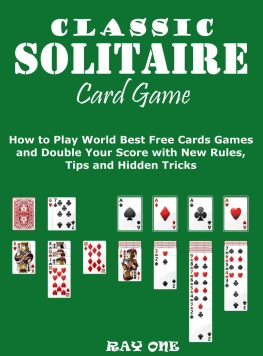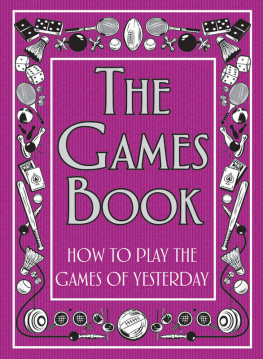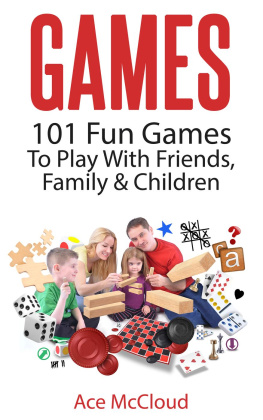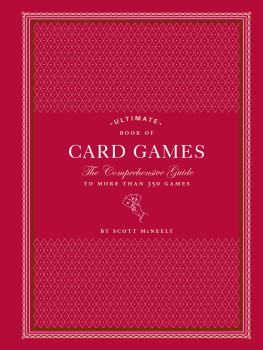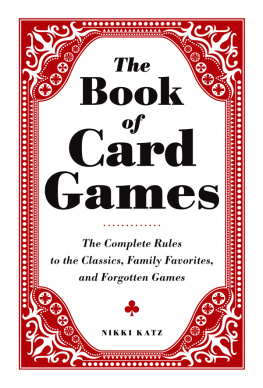TAG, TOSS & RUN
40 CLASSIC LAWN GAMES
Paul Tukey & Victoria Rowell

The mission of Storey Publishing is to serve our customers by
publishing practical information that encourages
personal independence in harmony with the environment.
Edited by Carleen Madigan and Lisa H. Hiley
Art direction by Alethea Morrison
Book design by woolypear
Text production by Jennifer Jepson Smith
Photography credits appear on page 204
Cover and primary game illustrations by Adam McCauley
Additional spot illustrations by woolypear
Indexed by Christine R. Lindemer, Boston Road Communications
2012 by Paul Tukey and Victoria Rowell
All rights reserved. No part of this book may be reproduced without written permission from the publisher, except by a reviewer who may quote brief passages or reproduce illustrations in a review with appropriate credits; nor may any part of this book be reproduced, stored in a retrieval system, or transmitted in any form or by any means electronic, mechanical, photocopying, recording, or other without written permission from the publisher.
The information in this book is true and complete to the best of our knowledge. All recommendations are made without guarantee on the part of the author or Storey Publishing. The author and publisher disclaim any liability in connection with the use of this information.
Storey books are available for special premium and promotional uses and for customized editions. For further information, please call 1-800-793-9396.
Storey Publishing
210 MASS MoCA Way
North Adams, MA 01247
www.storey.com
Printed in the United States by Versa Press
10 9 8 7 6 5 4 3 2 1
LIBRARY OF CONGRESS CATALOGING-IN-PUBLICATION DATA
Tukey, Paul.
Tag, toss & run / by Paul Tukey and Victoria Rowell.
p. cm.
Includes index.
ISBN 978-1-60342-560-5 (pbk. : alk. paper)
1. GamesJuvenile literature. 2. Outdoor gamesJuvenile literature. I. Rowell, Victoria. II. Title.
GV1203.T85 2012
790.1922dc23
2011049410
Dedication
To Dad and Marny and the Lessels family for keeping those lawn games alive and well in our lives for all these years
P. T.
To my loving children, Maya and Jasper, and my foster mother, Agatha Wooten Armstead, for raising me on Forest Edge, our 60-acre farm in West Lebanon, Maine, where she introduced me to so many fun backyard games, with laughter, love, and patience
V. R.

Contents

Introduction
The American people cannot fail to welcome a new book on play. Throughout our country there is a growing appreciation of its importance and its necessity during childhood and youth... no child can develop normally unless he has opportunities for a large amount of diversified play.
Michael Vincent OShea
Director of Education,
University of Wisconsin
We would like to believe that statement is as true as if it were spoken yesterday. But when Professor Michael Vincent OShea, the esteemed director of education at the University of Wisconsin, penned the above words in 1910, he could not possibly have contemplated that childrens play would come to be defined by computer and video games as much as by balls, bats, or hide-and-seek.
As authors of this book on childrens games, we have traveled the world on vastly disparate personal and public voyages. One of us has been a dancer, an actress, and an author, the other a sportswriter turned lawn care professional and magazine publisher. The common ground that fostered our collective dreams, however, was rural Maine in the 1960s. From one-room schoolhouses where the desks still had inkwells to fuzzy black-and-white televisions (if our families owned one at all) to party-line systems where neighbors took turns on their telephones (if they could afford one), ours was a world almost unimaginable to scores of children a half century later.
Without Game Boys or Nintendos or Wiis, and without iPods, iPhones, or instant messaging, life then probably sounds bleak to todays youth. But, oh, what fun we had! Our entire childhoods spent with nothing more than our own wits and the loveable nitwits and nincompoops from our neighborhoods were filled with endless outdoor games. Imagine this: our caregivers sent us through the front door in the morning with a sandwich in a brown bag and a canteen full of well water, but no cell phone, no pocket money, and, furthermore, no instructions other than to be home by dinnertime!
It wasnt that the adults in our lives didnt care about us. Quite the opposite. In our cases, however, they had farms to run, with long lists of chores, of which we were expected to do our share. When we were finished cooking, cleaning, and making our beds, the adults felt absolutely no responsibility to fill in our free time. And, as we discovered about each other, we both lived in an economic reality where store-bought toys and games were a rare privilege, not a right. It was as if the Grinch had come by to swipe our galooks and our great big electro-whocardio-shnoox and never brought them back!
But just as Christmas still comes in the fabled Dr. Seuss classic, we still found our fun each day. Yes, we were poor, but we truly never knew it. If you recall gathering frog spawn in a jam jar, trapping a salamander under a tuna can or, we admit it, swiping the occasional birds egg from a nest, you recall what we mean by fun. If you know the term jacking for worms or the thrill of catching fireflies in a jar at night, you know that the natural world holds more wonders than any megastore.
You may know that. But do your children?
For a new generation, nature is more abstraction than reality. Increasingly, nature is something to watch, to consume, to wear to ignore, wrote Richard Louv in Last Child in the Woods, the best-selling expos about a phenomenon known as nature deficit disorder that explains childrens disconnect with nature and all it represents.
The other issue, of course, is the physical and mental toll of a life lived in front of a computer and television. Obesity levels for 5- and 6-year-olds have doubled in the past decade and are even worse for teenagers. At least 10 percent of our kids have a diagnosed mental health problem ranging from attention deficit to hyperactivity to depression.
In bringing you this book, we are presenting a time-honored way for children to reconnect, not only with nature, but their communities, their comrades, their families, and their sense of self. In Tag, Toss & Run, we explore and perhaps introduce classic outdoor games in hopes that you will enjoy them with your children and teach your children to play them on their own. Whether played in your backyard, a public park, or in the paved nook of a cul-de-sac, these games, for children and the young at heart of all ages, are timeless treasures that if you let them will work their magic on your sons and daughters in the same way they might have nurtured you.
We think this book is at once timely and necessary, but its also a rollicking nostalgic ride for parents and grandparents who remember simpler, healthier times. As we recalled the playground and backyard games of our own childhoods, we laughed out loud at our own memories and relived some silly old fears of games that we originally found intimidating. We fondly recollected the exhilaration of being selected as captain, with the privilege of first pick. We chuckled at those common, old anxieties about swinging and missing, tripping awkwardly on the jump rope, or finishing last in a race. Those moments made the home runs and blue-ribbon finishes all the sweeter.


